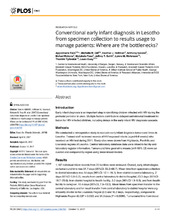| dc.contributor.author | Tiam, Appolinaire | en_US |
| dc.contributor.author | Gill, Michelle M | en_US |
| dc.contributor.author | Hoffman, Heather J | en_US |
| dc.contributor.author | Isavwa, Anthony | en_US |
| dc.contributor.author | Mokone, Mafusi | en_US |
| dc.contributor.author | Foso, Matokelo | en_US |
| dc.contributor.author | Safrit, Jeffrey T | en_US |
| dc.contributor.author | Mofenson, Lynne M | en_US |
| dc.contributor.author | Tylleskär, Thorkild | en_US |
| dc.contributor.author | Guay, Laura | en_US |
| dc.date.accessioned | 2018-08-28T08:59:30Z | |
| dc.date.available | 2018-08-28T08:59:30Z | |
| dc.date.issued | 2017-10-10 | |
| dc.Published | Tiam, Gill, Hoffman, Isavwa, Mokone, Foso, Safrit, Mofenson, Tylleskär T, Guay. Conventional early infant diagnosis in Lesotho from specimen collection to results usage to manage patients: Where are the bottlenecks? PLoS ONE. 2017;12(10):e0184769 | eng |
| dc.identifier.issn | 1932-6203 | |
| dc.identifier.uri | https://hdl.handle.net/1956/18283 | |
| dc.description.abstract | Introduction: Early infant diagnosis is an important step in identifying children infected with HIV during the perinatal period or in utero. Multiple factors contribute to delayed antiretroviral treatment initiation for HIV-infected children, including delays in the early infant HIV diagnosis cascade. Methods: We conducted a retrospective study to evaluate early infant diagnosis turnaround times in Lesotho. Trained staff reviewed records of HIV-exposed infants (aged-6-8 weeks) who received an HIV test during 2011. Study sites were drawn from Highlands, Foothills and Lowlands regions of Lesotho. Central laboratory database data were linked to facility and laboratory register information. Turnaround time geometric means (with 95% CI) were calculated and compared by region using linear mixed models. Results: 1,187 individual infant records from 25 facilities were reviewed. Overall, early infant diagnosis turnaround time was 61.7 days (95%CI: 55.3–68.7). Mean time from specimen collection to district laboratory was 14 days (95%CI: 12.1–16.1); from district to central laboratory, 2 days (95%CI 0.8–5.2); results from central laboratory to district hospital, 23.3 days (95%CI: 18.7–29.0); from district hospital to health facility, 3.2 days (95%CI 1.9–5.5); and from health facility to caregiver, 10.4 days (95%CI, 7.9–13.5). Mean times from specimen transfer to the central laboratory and for result transfer from central laboratory to district hospital were significantly shorter in the Lowlands Region (0.9 and 16.2 days, respectively), compared to Highlands Region (6.0 [P = 0.030] and 34.3 days [P = 0.0099]. Turnaround time from blood draw to receipt of results was significantly shorter for HIV infected infants compared to HIV uninfected infants [p = 0.0036] at an average of 47.1 days (95%CI: 38.9–56.9) and 62 days (95%CI: 55.9–68.7) respectively. Of 47 HIV-infected infants, 36 were initiated on antiretroviral therapy at an average of 1.3 days (95%CI: 0.3, 5.7) after caregiver received the result. Conclusion: HIV-infected infants received results earlier and were rapidly initiated on antiretroviral therapy once the result was delivered to caregiver. However, average early infant diagnosis turnaround time was two months; the longest period of delay was transfer of results from central laboratory to district hospital. Turnaround time of results based on geographical regions or between hospitals and health centres varied but did not reach statistical significance. | en_US |
| dc.language.iso | eng | eng |
| dc.publisher | PLOS | eng |
| dc.rights | Attribution CC BY | eng |
| dc.rights.uri | http://creativecommons.org/licenses/by/4.0 | eng |
| dc.title | Conventional early infant diagnosis in Lesotho from specimen collection to results usage to manage patients: Where are the bottlenecks? | en_US |
| dc.type | Peer reviewed | |
| dc.type | Journal article | |
| dc.date.updated | 2018-03-07T10:56:35Z | |
| dc.description.version | publishedVersion | en_US |
| dc.rights.holder | Copyright 2017 The Author(s) | |
| dc.identifier.doi | https://doi.org/10.1371/journal.pone.0184769 | |
| dc.identifier.cristin | 1549644 | |
| dc.source.journal | PLoS ONE | |

